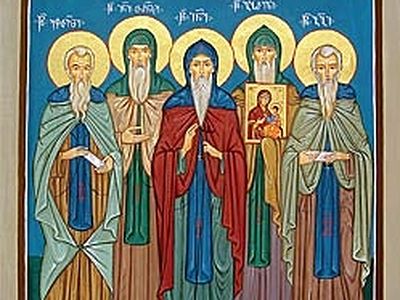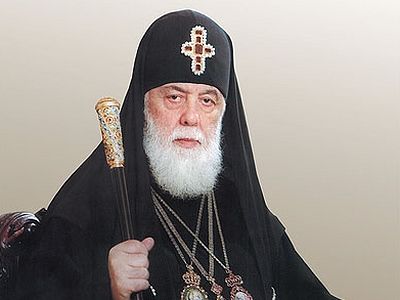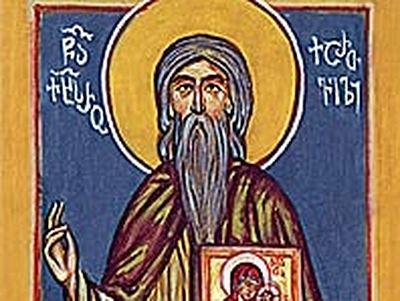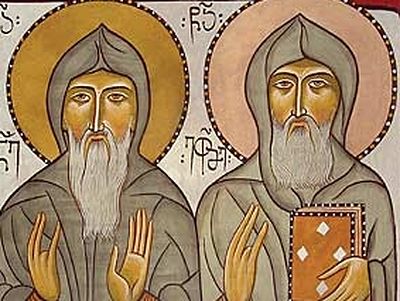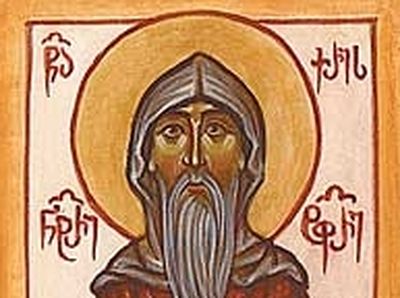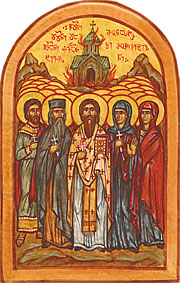Memory 13 (26) June
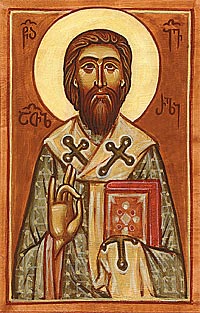 St. Antimos the Iberian
St. Antimos the Iberian
|
| St. Antimos the Iberian |
Saint Antimos of Iberia was one of the most highly educated people of his time. He was fluent in many languages, including Greek, Romanian, Old Slavonic, Arabic, and Turkish and well-versed in theology, literature, and the natural sciences. He was unusually gifted in the fine arts — in painting, engraving, and sculpture in particular. He was famed for his beautiful calligraphy. Finally, St. Antimos was a great writer, a renowned orator, and a reformer of the written Romanian language.
Little is known about the youth of St. Antimos. He was a native of the Samtskhe region in southern Georgia. His parents, Ioane and Mariam, gave him the name Andria at Baptism. He accompanied King Archil to Russia and helped him to found a Georgian print shop there, but after he returned he was captured by Dagestani robbers and sold into slavery. Through the efforts of Patriarch Dositheus of Jerusalem, Antimos was finally set free, but he remained in the patriarch’s service in order to further his spiritual education.
Already famed for his paintings, engravings, and calligraphy, Antimos was asked by Prince Constantine Brincoveanu (1688–1714) of Wallachia (present-day Romania) to travel to his kingdom around the year 1691. After he had arrived inWallachia, he began to manage a local print shop. The printing industry in that country advanced tremendously at that time, and the chief inspiration and driving force behind the great advances was the Georgian master Antimos. He succeeded in making Wallachia a center of Christianity and a major publisher of books for all the East.
In 1694 Antimos was enthroned as abbot of Snagov Monastery (in present-day Romania), where he soon founded a print shop. In the same year his new print shop published Guidelines for the Divine Services on May 21, All Saints’ Day. The book was signed by Subdeacon Michael Ishtvanovich, future founder of the first Georgian print shop.
In 1705 Antimos, “the chosen among chosen abbots of Wallachia,” was consecrated bishop of Rimnicu Vilcea, and in 1708 he was appointed metropolitan of Hungro-Wallachia. The whole country celebrated his elevation. As one abbot proclaimed: “The divine Antimos, a great man and son of the wise Iberian nation, has come to Wallachia and enlightened our land. God has granted him an inexhaustible source of wisdom, entrusted him to accomplish great endeavors, and helped to advance our nation by establishing for us a great printing industry.”
Under the direct leadership of St. Antimos, more than twenty churches and monasteries were erected in Wallachia. Of particular significance is All Saints’ Monastery, located in the center of Bucharest.
The main gates of this monastery were made of oak and carved with traditional Georgian motifs by St. Antimos himself. The metropolitan also established rules for the monastery and declared its independence from the Church of Constantinople.
From the day of his consecration, Metropolitan Antimos fought tirelessly for the liberation of Wallachia from foreign oppressors. On the day he was ordained he addressed his flock: “You have defended the Christian Faith in purity and without fault. Nevertheless, you are surrounded and tightly bound by the violence of other nations. You endure countless deprivations and tribulations from those who dominate this world…. Though I am unworthy and am indeed younger than many of you — like David, I am the youngest among my brothers — the Lord God has anointed me to be your shepherd. Thus I will share in your future trials and griefs and partake in the lot that God has appointed for you.”
His words were prophetic: In 1714 the Turks executed the Wallachian prince Constantine Brincoveanu, and in 1716 they executed Stefan Cantacuzino (1714–1716), the last prince of Wallachia.
In his place they appointed the Phanariote[1] Nicholas Mavrokordatos, who concerned himself only with the interests of the Ottoman Empire.
During this difficult time, Antimos of Iberia gathered around him a group of loyal boyar patriots determined to liberate their country from Turkish and Phanariote domination. But Nicholas Mavrokordatos became suspicious, and he ordered Antimos to resign as metropolitan. When Antimos failed to do so, he filed a complaint with Patriarch Jeremiah of Constantinople. Then a council of bishops, which did not include a single Romanian clergyman, condemned the “conspirator and instigator of revolutionary activity” to anathema and excommunication and declared him unworthy to be called a monk.
But Nicholas Mavrokordatos was still unsatisfied and claimed that to deny Antimos the title of Metropolitan of Hungro-Wallachia was insufficient punishment. He ordered Antimos to be exiled far from Wallachia, to St. Catherine’s Monastery on Mt. Sinai. Metropolitan Antimos, beloved of the Romanian people, was escorted out of the city at night since the conspirators feared the reaction of the people.
But Metropolitan Antimos never reached Mt. Sinai.
On September 14, 1716, a band of Turkish soldiers stabbed St. Antimos to death on the bank of the Tundzha (Tunca) River where it flows through Adrianople, not far from Gallipoli, and cast his butchered remains into the river.
Thus ended the earthly life of one more Georgian saint — a man who had dedicated all of his strength, talent, and knowledge to the revival of Christian culture and the strengthening of theWallachian people in the Orthodox Faith.
In 1992 the Romanian Church canonized Antimos of Iberia and proclaimed his commemoration day to be September 14, the day of his repose. The Georgian Church commemorates him on June 13.
Thou didst dwell on earth as an angel, O Holy Hierarch Antimos, and now thy soul rejoices with the angels above. Grant that we also may be made worthy of everlasting life!
[1] Phanariote: a member of one of the principal Greek families of the Phanar, the Greek quarter of Constantinople, who, as administrators in the civil bureaucracy, exercised great influence in the Ottoman Empire after the Turkish conquest.
